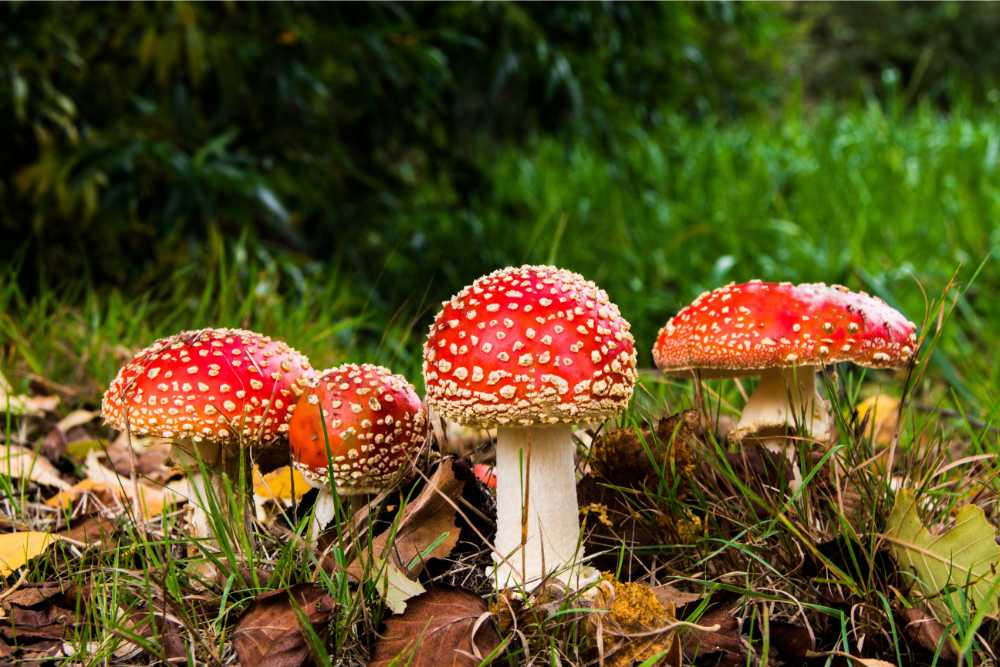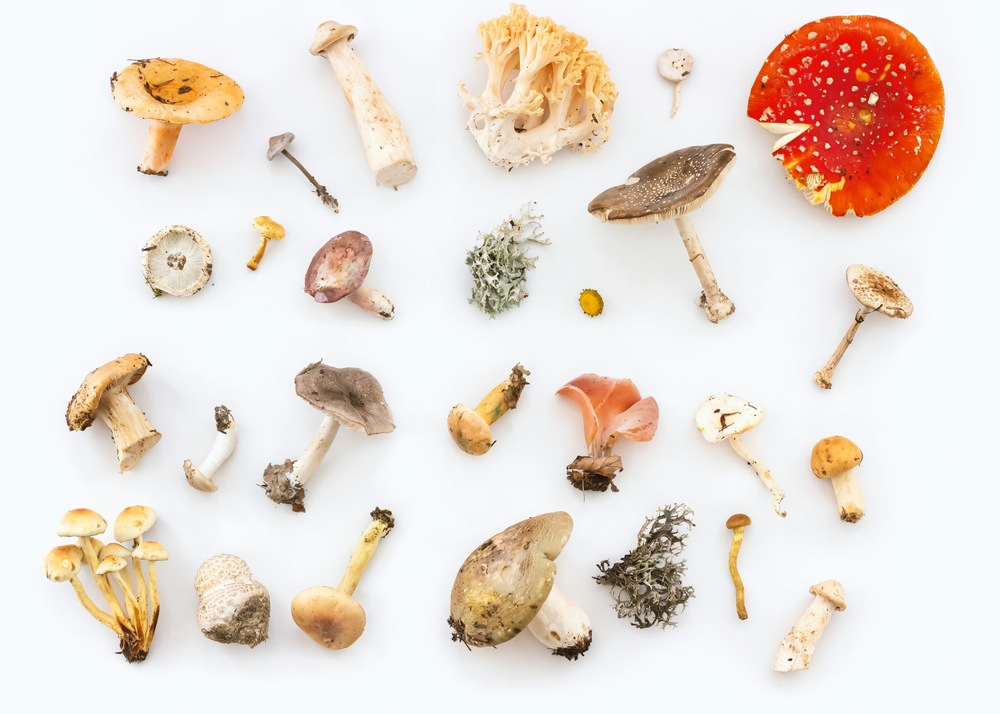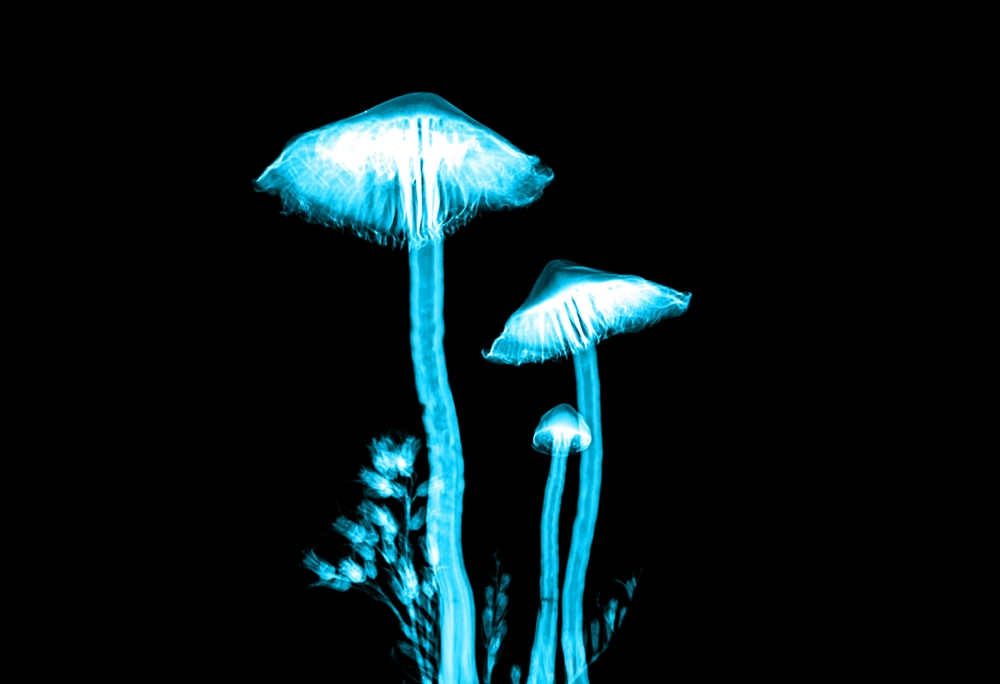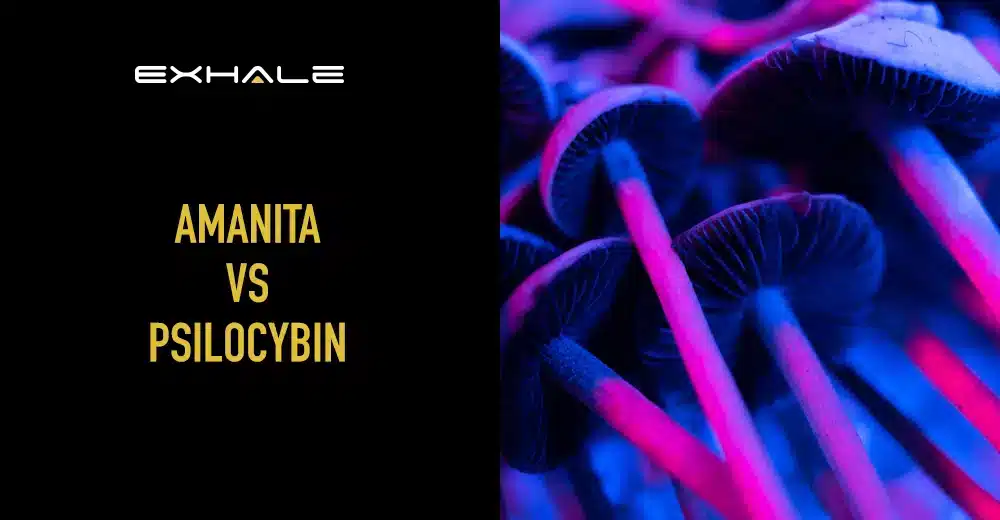Two species stand out in the realm of edible mushrooms: Amanita vs Psilocybin mushrooms. Known respectively as the fly agaric and magic mushrooms or shrooms, they have distinct characteristics and effects. Understanding these disparities is essential, especially concerning these substances’ safety and recreational use.
Amanita Muscaria boasts a visually striking appearance with its red cap adorned with white spots. At the same time, Psilocybin mushrooms encompass various species renowned for their psychoactive properties, such as Conocybe and Galerina.
Distinguishing between the two is vital due to their differing effects and risks. Psilocybin mushrooms offer psychedelic experiences, while Amanita muscaria contains hallucinogenic properties, as well as toxins that can induce adverse effects like nausea and hallucinations.
I suggest you continue reading. This article will thoroughly iron out the differences between these fungi and also educate those considering experiencing Amanita Muscaria and Psilocybin mushrooms, as misidentification could lead to severe consequences.

Amanita Vs. Psilocybin Mushrooms
Amanita
How They Work
You can consume Amanita mushrooms however you like, whether raw or dried, brewed into teas or gummies, or incorporated into dishes. Whatever mode of consumption you choose for your Amanita muscaria mushrooms doesn’t matter because the mechanism of action remains the same.
When ingested, Fly Agaric mushrooms/ Amanita Muscaria mushrooms’ psychoactive compounds, like muscimol and ibotenic acid, interact with neurotransmitter receptors in the brain, particularly the gamma-aminobutyric acid (GABA) receptors, causing a range of effects on the mind and body.
Effects On The Mind
Amanita muscaria mushrooms contain various compounds, including muscimol and ibotenic acid, which affect the mind in unique ways; these are why they are referred to as psychedelic mushrooms. When ingested, these mushrooms can induce a range of effects, including altered perception, euphoria, and hallucinations. However, these experiences are often unpredictable and can vary widely from person to person.
Despite their potential for inducing psychedelic experiences, Amanita muscaria mushrooms also pose significant risks. Adverse effects like nausea, dizziness, and vomiting are common, and in some cases, ingestion can lead to more severe adverse effects like confusion, delirium, and even seizures. Additionally, individuals with underlying medical conditions, especially liver or kidney disorders, compromised immune systems, or mental illnesses, should exercise extreme caution when considering the consumption of Amanita muscaria mushrooms. Before use, consulting with a healthcare professional is strongly advised to mitigate potential risks and ensure safety.
Effects On The Body
Consumption of Amanita muscaria mushrooms can induce a range of bodily effects distinct from their psychoactive impact on the mind. These effects include gastrointestinal disturbances like nausea, vomiting, and diarrhea stemming from toxins like ibotenic acid and muscimol. Muscle weakness and twitching may also occur due to compounds affecting neuromuscular function. Sweating and increased salivation are common, triggered by the mushroom’s toxins stimulating sweat and salivary glands. Changes in blood pressure and heart rate may also manifest, alongside potential urinary retention. These effects emphasize the importance of understanding the bodily responses to Amanita muscaria ingestion, emphasizing caution and awareness to mitigate adverse outcomes.
Legality
The legal status of Amanita muscaria, or the fly agaric mushroom, varies, reflecting its complex cultural, historical, and psychoactive nature. Its use may be legally permitted for traditional ceremonies in regions like Scandinavia and Siberia, where it holds deep-rooted cultural and shamanic importance. Conversely, in many countries, including several European nations and Australia, regulations restrict or prohibit its sale and consumption due to its psychoactive properties and associated health risks.
In the United States, while Amanita muscaria is not federally classified as a controlled substance, its legality varies by state. States like California, Oregon, and Washington, where it grows naturally and has cultural relevance, may have more lenient regulations for its use in indigenous ceremonies. However, in most states, its possession and sale for recreational purposes are subject to strict regulations or outright prohibition under state law. Therefore, individuals should be mindful of local laws and be cautious when considering Amanita muscaria.

Psilocybin
How They Work
Magic mushrooms, like LSD, are psychotropic drugs that affect the central nervous system, inducing altered states of consciousness. They’re often described as producing a milder, shorter version of an LSD trip. Contrary to popular belief, they don’t directly cause hallucinations but rather distort perceptions of reality. Users may experience shifts in colors, patterns, sensory perceptions, intensified emotions, and altered time perception. Additionally, there can be a profound connection with the universe and a feeling of communion with a higher power.
Basically, Magic mushrooms work by altering perception and inducing profound introspective experiences akin to a spiritual journey.
Effects On The Mind
Psilocybin mushrooms, known for their psychedelic effects, engage serotonin receptors in the brain, inducing perceptual shifts, emotional changes, and even spiritual awakenings. This interaction fosters neuroplasticity, reshaping neural connections and enabling profound personal insights and transformation. The experience typically includes vivid visuals, such as halos and vibrant colors, and a sense of the world breathing and reframed memories. These effects onset within 30 to 60 minutes, peak after 1-2 hours, and linger for 4-6 hours, sometimes followed by an “afterglow” period lasting days. In contrast, Amanita muscaria elicits psychoactive effects resembling alcohol intoxication, with deep sleep and dream-like visions. Muscimol, its active compound, lacks the hallucinatory and mind-expanding qualities of Psilocybin, manifesting as physical relaxation, euphoria, blurred vision, and impaired motor skills.
Learn more about what are mushroom chocolate bars
Effects On The Body
The effects of Psilocybin on the body are predominantly psychological rather than physical, distinguishing it from many other substances. Psilocybin mushrooms are among the least toxic substances used to induce psychedelic effects, with recorded cases of death from mild doses being exceedingly rare. While experiments using animal models have determined lethal doses, such occurrences in humans are highly uncommon.
Physically, the effects of psilocybin mushrooms are generally minor and vary among individuals. Common short-term reactions include dilated pupils, elevated blood pressure, and increased heart rate, often accompanied by emotional intensification. Additionally, mild symptoms like nausea, perspiration, numbing, and tremors may occur, potentially exacerbating psychological effects such as anxiety, panic attacks, paranoia, and mood swings.
Legality
Psychedelic mushrooms, despite recent decriminalization or legalization efforts in states like Colorado and Oregon, remain classified as controlled substances in the United States, rendering them illegal at the federal level. However, there’s a glimmer of hope in research and medical applications. Both the Food and Drug Administration (FDA) and the Drug Enforcement Agency (DEA) have permitted select, tightly controlled human studies exploring the therapeutic potential of Psilocybin in medical and psychiatric contexts. Furthermore, the FDA’s recognition of Psilocybin as a “breakthrough therapy” for depression signals a potential breakthrough in treatment-resistant depression. This designation may expedite the development of psilocybin-based treatments, offering new hope for individuals struggling with mental health disorders.
What is Amanita?
Amanita muscaria, also known as fly agaric, stands out with its iconic red-and-white speckles, which often appear in cultural symbols like garden statues and emojis. While possessing psychoactive properties, it differs from traditional magic mushrooms in several key aspects.
Amanita mushrooms contain muscimol, ibotenic acid, and muscarine as primary active compounds, which can induce relaxation, euphoria, and dream-like states. However, it’s crucial to note that consuming raw Amanita muscaria mushrooms can be toxic, as they are related to deadly varieties like Amanita Phalloides. The Amanita genus encompasses various agarics, some toxic and others edible, underscoring the importance of accurate identification and proper preparation when foraging mushrooms.
What is Psilocybin?
Mushrooms that possess bio-psychoactive alkaloids like Psilocybin are commonly known as “magic mushrooms” or “shrooms.” These types of mushrooms are naturally occurring psychedelic compound which, when ingested, converts Psilocybin into psilocin, inducing psychedelic effects. These mushrooms predominantly inhabit meadows and woods of tropical and subtropical forests, thriving in soil rich in humus and plant debris. They often grow near dead tree stumps, decaying wood, or in sunlit grassy areas and have even been observed near religious sites like churches and temples.
Characterized by light tan to off-white caps and white to brown stems, psychedelic mushrooms encompass over 200 species containing Psilocybin or its derivative, psilocin. Psilocybe cubensis, particularly the “Golden Teachers” subspecies, is famous for its gentle, guiding effects.
Read more about the potential benefits of amanita muscaria mushrooms
Amanita Vs. Psilocybin Mushrooms: Which is Right for You?
While both Amanita muscaria and Psilocybin mushrooms have psychoactive properties, their effects and potency differ significantly. Choosing between Products rich in Amanita Muscaria extract or Psilocybin-containing mushrooms is tricky. Before making a choice, you must educate yourself on their effects and potency to make an informed decision. Here’s a summary of the effects and potency of each substance to guide you in your decision-making process.

Amanita vs Psilocybin Mushrooms: Effects
Amanita Muscaria Effects:
- Amanita muscaria is known to induce alterations in perception, often distorting colors, shapes, and sizes of objects.
- Users may experience a range of physical sensations, including relaxation, dizziness, and changes in body temperature.
- The emotional effects of Amanita muscaria can vary, with some users reporting feelings of euphoria or introspection while others may experience confusion or anxiety.
Psilocybin Mushrooms Effects:
- Psilocybin mushrooms are renowned for their visual and sensory effects, often enhancing colors, patterns, and textures.
- Users commonly report profound emotional experiences, increased empathy, and reflective insights.
- Psilocybin mushrooms have been associated with spiritual experiences and a sense of connection with nature or the universe.
Amanita Vs. Psilocybin Mushrooms: Potency
Amanita Muscaria Potency:
- The effects of Amanita muscaria mushroom can vary widely depending on factors such as dosage, individual sensitivity, and preparation method.
- Due to its potency and variability, users should start with a mild dose before trying higher doses.
Psilocybin Mushrooms Potency:
- Psilocybin mushrooms typically offer more predictable effects than Amanita muscaria, with dosage guidelines and standardized potency.
- When buying from a particular brand, users can follow dosage recommendations based on the specific strain of Psilocybin mushrooms available for purchase, allowing for a more controlled and consistent experience.
Final Thoughts – Amanita vs Psilocybin Mushrooms [What Are the Differences?]
Choosing between Amanita muscaria and Psilocybin mushrooms ultimately depends on individual preferences, risk tolerance, and desired effects. By understanding the distinct characteristics of each variety, users can make informed decisions and approach their psychedelic experiences responsibly.



